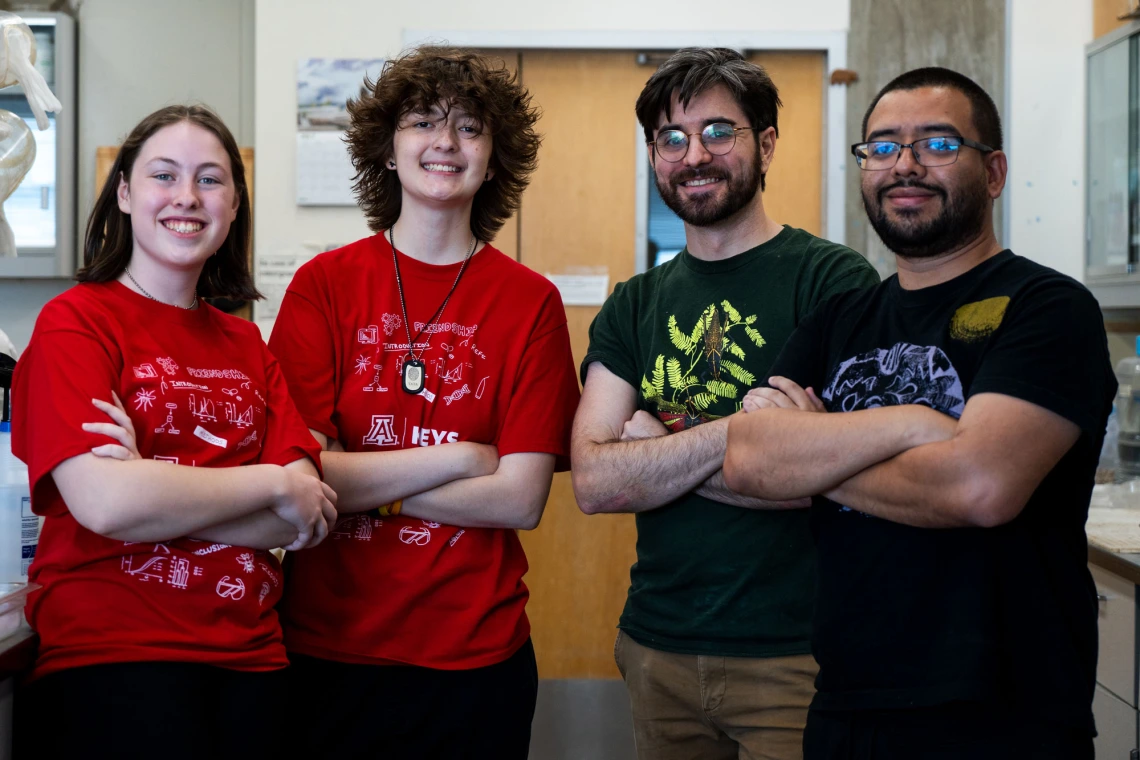Studying symbiosis to tackle agricultural pests
2025 Tucson KEYS interns James Jirousek (they/he) and Sara Porter (she/her) explored the mutually beneficial relationship, or symbiosis, between insects and bacteria in the Martha Hunter lab.

2025 Tucson KEYS intern James Jirousek (second from left) from the Academy of Tucson worked with doctoral candidate Edwin Umanzor (far right) to measure how many bacteria leaf-footed bugs carry in a special organ in their gut, while 2025 KEYS intern Sara Porter (left) studied with doctoral candidate Liam Sullivan (second from right) to learn how the young leaf-footed bugs find the bacteria they need.
Deanna Rodriguez, BIO5 Institute
The research of Martha Hunter, professor of entomology, and her lab at the University of Arizona College of Agriculture, Life & Environmental Sciences explores the mutually beneficial relationship, or symbiosis, between insects and bacteria. These tiny microbes can help bugs grow, survive, and even reproduce. The Hunter lab focuses on crop pests like the leaf-footed bug, which feeds on Arizona-grown pomegranates and depends on bacteria housed in its gut.
Tucson KEYS interns James Jirousek (they/he) and Sara Porter (she/her) helped unravel how these insect-bacteria relationships work. Jirousek, mentored by doctoral candidate Edwin Umanzor, measured how many bacteria the bugs carry in a special organ in their gut.
“James is so full of curiosity and ideas that it really makes you think differently about the research,” said Umanzor. “That fresh perspective can lead to questions no one’s thought to ask.”

Edwin Umanzor (left) showing James Jirousek (right) leaf-footed bugs, agricultural pests common in Arizona.
Emilia Gazman, BIO5 Institute
Using a technique called qPCR, which counts bacterial DNA, they're investigating whether bugs with more bacteria reproduce more successfully.
“Before this, I hadn’t thought much about how bugs and bacteria interact,” said Jirousek. “Now I ask questions I’d never considered, and I’m even more excited to study ancient life as a future paleontologist.”
At the same time, Porter worked with doctoral candidate Liam Sullivan to study how young bugs find the bacteria they need. Using a Y-tube olfactometer—a tool that tests insect responses to different smells—she’s testing whether bugs are drawn to the scent of beneficial bacteria.
“The most fun part of science is teaching others why it matters,” said Sullivan. “When someone else gets excited about the same tiny detail you do, it’s incredibly rewarding.”

Sara Porter using a tool that tests insect responses to different smells.
Emilia Gazman, BIO5 Institute
Porter’s results can help scientists understand how insects locate the microbes they rely on in the wild.
“I wanted to see if this is something I’d want to do for the rest of my life, and now I know I do,” said Porter. “I’d love to help spread a joy for learning and inspire others to care about how things work.”
Together, these projects support the lab’s broader goal of improving pest control through a deeper understanding of insect-bacteria partnerships.
“Bright students like our KEYS interns can ask fundamental questions that we may have overlooked,” said Hunter. “An irony of science is that while we are seeking answers, it’s the abundance of questions that pull us forward with excitement.”
Take a closer look at how KEYS interns are helping advance real-world research across Arizona.

